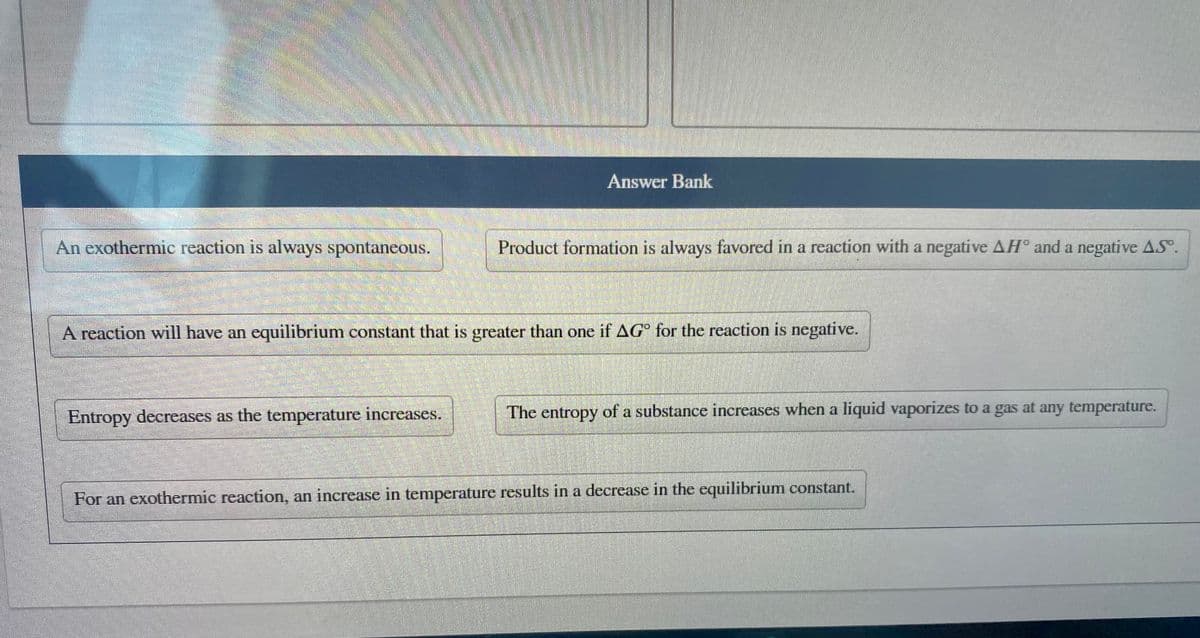An exothermic reaction is always spontaneous. Product formation is always favored in a reaction with a negative AH° and a negative A.S. A reaction will have an equilibrium constant that is greater than one if AG for the reaction is negative. Entropy decreases as the temperature increases. The entropy of a substance increases when a liquid vaporizes to a gas at any temperature. For an exothermic reaction, an increase in temperature results in a decrease in the equilibrium constant.
An exothermic reaction is always spontaneous. Product formation is always favored in a reaction with a negative AH° and a negative A.S. A reaction will have an equilibrium constant that is greater than one if AG for the reaction is negative. Entropy decreases as the temperature increases. The entropy of a substance increases when a liquid vaporizes to a gas at any temperature. For an exothermic reaction, an increase in temperature results in a decrease in the equilibrium constant.
Chemistry & Chemical Reactivity
9th Edition
ISBN:9781133949640
Author:John C. Kotz, Paul M. Treichel, John Townsend, David Treichel
Publisher:John C. Kotz, Paul M. Treichel, John Townsend, David Treichel
Chapter18: Principles Of Chemical Reactivity: Entropy And Free Energy
Section: Chapter Questions
Problem 68SCQ: Explain why each of the following statements is incorrect. (a) Entropy increases in all spontaneous...
Related questions
Question
100%
Select the statements which are true.

Transcribed Image Text:An exothermic reaction is always spontaneous.
Answer Bank
Entropy decreases as the temperature increases.
Product formation is always favored in a reaction with a negative AH° and a negative A.S.
A reaction will have an equilibrium constant that is greater than one if AGº for the reaction is negative.
The entropy of a substance increases when a liquid vaporizes to a gas at any temperature.
For an exothermic reaction, an increase in temperature results in a decrease in the equilibrium constant.
Expert Solution
This question has been solved!
Explore an expertly crafted, step-by-step solution for a thorough understanding of key concepts.
This is a popular solution!
Trending now
This is a popular solution!
Step by step
Solved in 2 steps

Knowledge Booster
Learn more about
Need a deep-dive on the concept behind this application? Look no further. Learn more about this topic, chemistry and related others by exploring similar questions and additional content below.Recommended textbooks for you

Chemistry & Chemical Reactivity
Chemistry
ISBN:
9781133949640
Author:
John C. Kotz, Paul M. Treichel, John Townsend, David Treichel
Publisher:
Cengage Learning

Chemistry & Chemical Reactivity
Chemistry
ISBN:
9781337399074
Author:
John C. Kotz, Paul M. Treichel, John Townsend, David Treichel
Publisher:
Cengage Learning

Chemistry: An Atoms First Approach
Chemistry
ISBN:
9781305079243
Author:
Steven S. Zumdahl, Susan A. Zumdahl
Publisher:
Cengage Learning

Chemistry & Chemical Reactivity
Chemistry
ISBN:
9781133949640
Author:
John C. Kotz, Paul M. Treichel, John Townsend, David Treichel
Publisher:
Cengage Learning

Chemistry & Chemical Reactivity
Chemistry
ISBN:
9781337399074
Author:
John C. Kotz, Paul M. Treichel, John Townsend, David Treichel
Publisher:
Cengage Learning

Chemistry: An Atoms First Approach
Chemistry
ISBN:
9781305079243
Author:
Steven S. Zumdahl, Susan A. Zumdahl
Publisher:
Cengage Learning

Chemistry
Chemistry
ISBN:
9781305957404
Author:
Steven S. Zumdahl, Susan A. Zumdahl, Donald J. DeCoste
Publisher:
Cengage Learning


Chemistry: The Molecular Science
Chemistry
ISBN:
9781285199047
Author:
John W. Moore, Conrad L. Stanitski
Publisher:
Cengage Learning